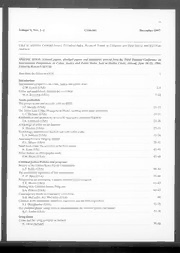
Security Journal 1997: Vol 9 Table of Contents PDF
Preview Security Journal 1997: Vol 9 Table of Contents
Volume 9, Nos. 1-3 Contents December 1997 Cited in: ASISNet, Criminal Justice Periodical Index, Research Trends in Computer and Data Survey and Sociology Abstracts SPECIAL ISSUE: Selected papers, abridged papers and summaries derived from the Third Biennial Conference on International Perspectives on Crime, Justice and Public Order, held at Dublin Castle, Ireland, June 16-21, 1996. Edited by Robert D McCrie Note from the Editor-in-Chief Introduction International perspective on crime, justice and public order G.W. Lynch (USA) Crime and punishment: Dostoevsky revivified W.A. Reynolds (USA) Assets protection The private sector and security: a bit on BIDS J.P. Murphy (USA) The Toller Lane Crime Management Model: tackling crime more effectively L.C. Bellamy (USA) Randomness and spontaneity in security negligence premises litigation J.H. Lombardi (USA) A typology of crime on the Internet E. Metchik (USA) Technology, international markets and whit-collar crime L.A. Sullivan (USA) Assessing forensic imaging options H.L. Blitzer (USA) Small boat crime: the activities of the boat owner N. Kasic (UK) Police humor: an ethnographic study P.M. Hayes (USA) Criminal justice-Policies and programs History of the United States Parole Commission E.F. Reilly (USA) The community legitimacy of law enforcement P. O’ Hara (USA) Perspectives on developing a quality criminal justice program T.K. Moran (USA) Starting New Criminal Justice Programs S.A. Powers (USA) Contemporary trends in community corrections B.R. McCarthy, B.J. McCarthy (USA) Cameras in the courtroom: American experience and the Irish experiment E.J. Shaughnessy (USA) Our pixilated planet: using video to internationalize the criminal justice curriculum K.C. Jordan (USA) Drug abuse Crime and the ‘drug problem’ in Ireland N. Owen (Ireland) Vili The globalization of the drug trade R.S. Gelbard (USA) Implementing a continuum of drug-abuse prevention and treatment services based on a biopsychosocial framework K.E. Coughlin (New York) Policing issues—Ireland Discretion and policing in Ireland P.J. Moran (Ireland) Rethinking the origins of preventive policing: 17th century Dublin, Ireland, the first American style police? S.A. Lentz, R.H. Chaires (USA) The ethics of police interrogation and the Garda Siochana P. O’Mahony (Ireland) Supporting Irish victims J. Guinness (Ireland) Policing issues—The United States Social control and police accountability in the United States P.V. Murphy (USA) 99-100 Revolutionizing the police: fighting crime in New York City E.B. Silverman, P.E. O’Connell (USA) 101-104 Socio-economic correlates of crime in the Brownsville section of New York City R. Hamilton (USA) 105-113 What the international community expects: the role of international human rights standards in domestic policing P.A. Lacovara (USA) 115-117 Global issues in organized crime B.R. Ferreira (USA) . 119-121 The role of community in securing peace and delivering justice T.J. Quinn (USA) 123-131 Policing issues—The United Kingdom Inspecting the police in England and Wales A.P. Williams (UK) 133-134 International perspectives on criminal justice J.A. Stevens (UK) 135-137 Making sense of media representations of British policing: implications for the police image R. Mawby (UK) 139-142 Police accountability in a divided society: lessons from Northern Ireland D. Walsh (Ireland) 143-145 Police consolidation in Germany and the United Kingdom M.F. Meine (USA) 147-155 Global messages and local criminal justice cultures: consultation and change through focus groups M. Davies (UK) 157-158 Postmodern police training? D. Hayes, M. Lofthouse (UK) 159-161 Policing issues—Other nations Victimization and fear of crime in Western Europe M. Murck (Germany) 163-164 Organized crime in Russia: theory and practice Y. Gilinskiy (Russia) 165-169 Public order police training in Turkey and its impact on police practices I. Cerrah (Turkey) 171-176 The Dutch criminal justice system: a crisis of identity M. Punch (Netherlands) 177-184 Quality assurance in Finnish community policing P. Raivola, H. Kiehela, A. Sarjanen (Finland) 185-189 Lack of symbolic representation in drawing and play, and children’s aggressive behavior P. Bonaiuto, V. Biasi (Italy) 191-194 Drug crime in the transit zone N.A. Ogilvie (USA) 195-196 Psychological factors in crime Multiple meanings in aggressive behavior of children and pre-adolescents A.M. Giannini (Italy) 197-198 Public perceptions regarding police response to domestic violence M.G. Breci, J.E. Murphy (USA) 199-202 Pathological anger in ‘crimes of passion’ S. Tsytsarev (USA) 203—204 Multiple personality and criminal law R. Slovenko (USA) 205-207 Theoretical issues in criminal justice Solutions to James Q. Wilson’s policy dilemma D. Goodman, R. Bonn (USA) 209-212 Terrorism as mass communication J.W. Williams (USA) 213-215 Criminal means and political ends R.R. Sullivan (USA) 217-220 Explaining crime in America D.P. Geary (USA) 221-222 The law and politics of race and criminal justice: the cases of ‘crack’ cocaine and capital punishment in the United States H.J. Sullivan (USA) Inmates idleness : is work an answer? B.R. Price, N.F. Jacobs (USA) Workplace violence How communication behavior affects perceived trustworthiness J.M. Huegli, D.L. Kelley, G.L. Fischer (USA) Youth and crime The prevention of aggression in children: what do we know? J.M. Levin (USA) Addressing psychological deficit in the therapeutic management of aggressive displays in children C.L. Katz (USA) 239-240 Youth gangs of South Texas S.L. Rogers (USA) 241-243 Child victimization and safety strategies for children N.A. McBride (USA) 245-246 Book review 247-248 Protection in the press 249-253 Calendar 255-256 Author index 257-258 Subject index 259 Instructions to authors 261-264
